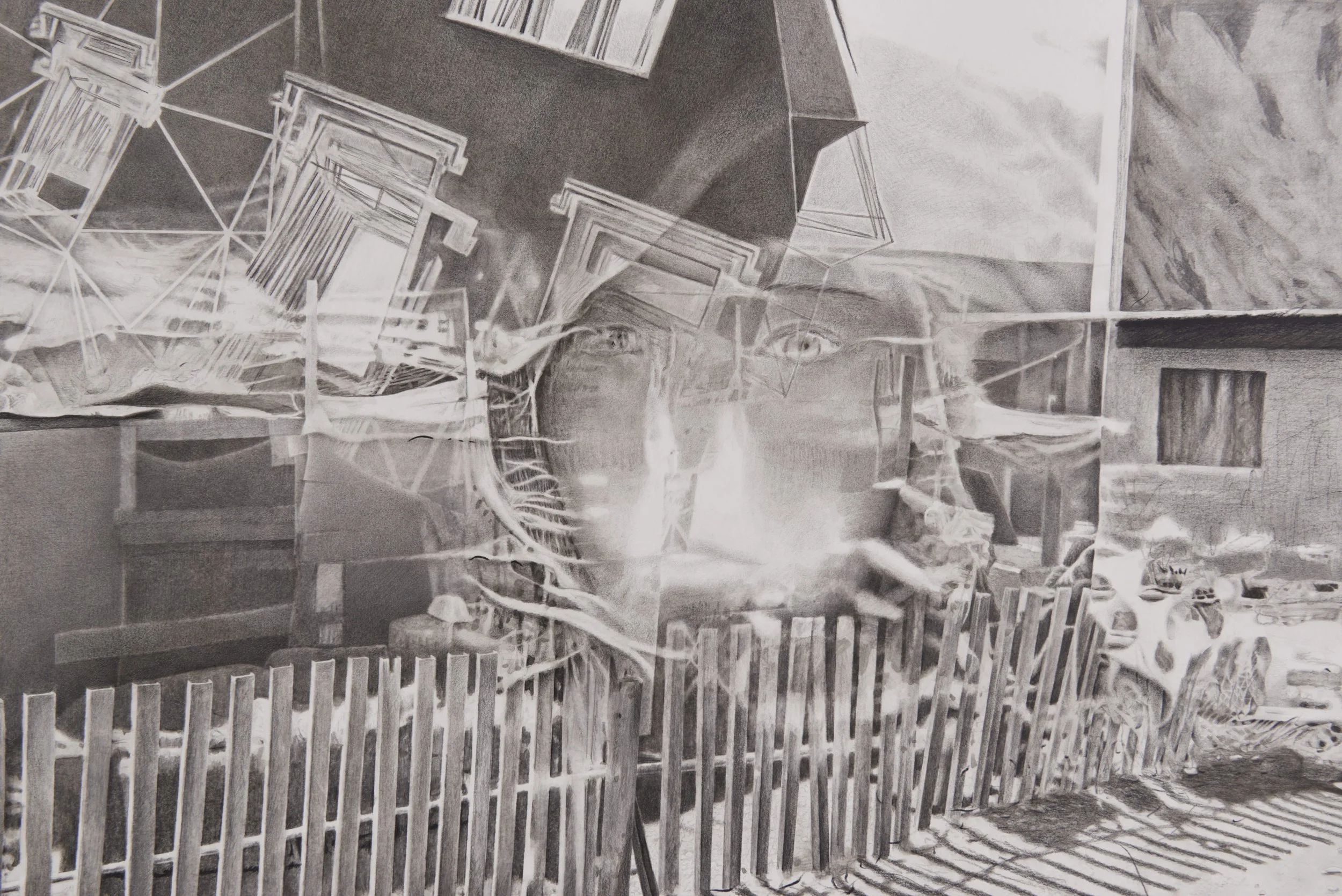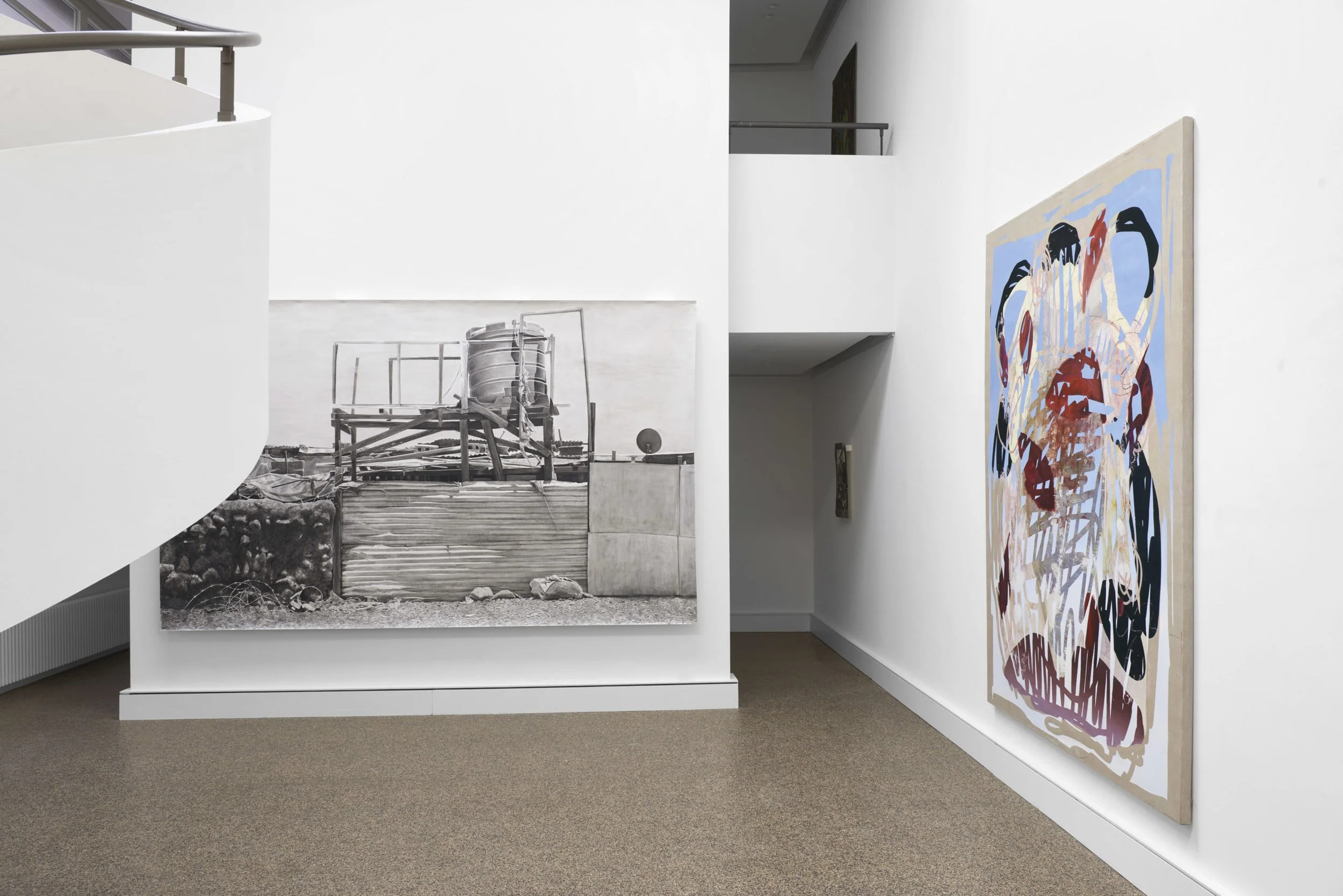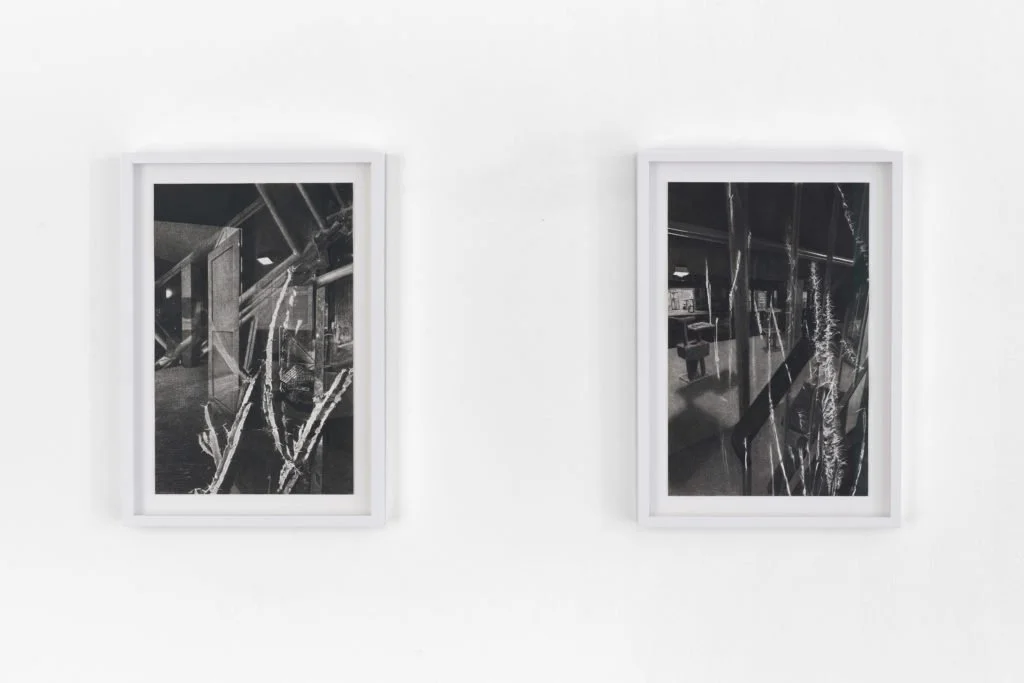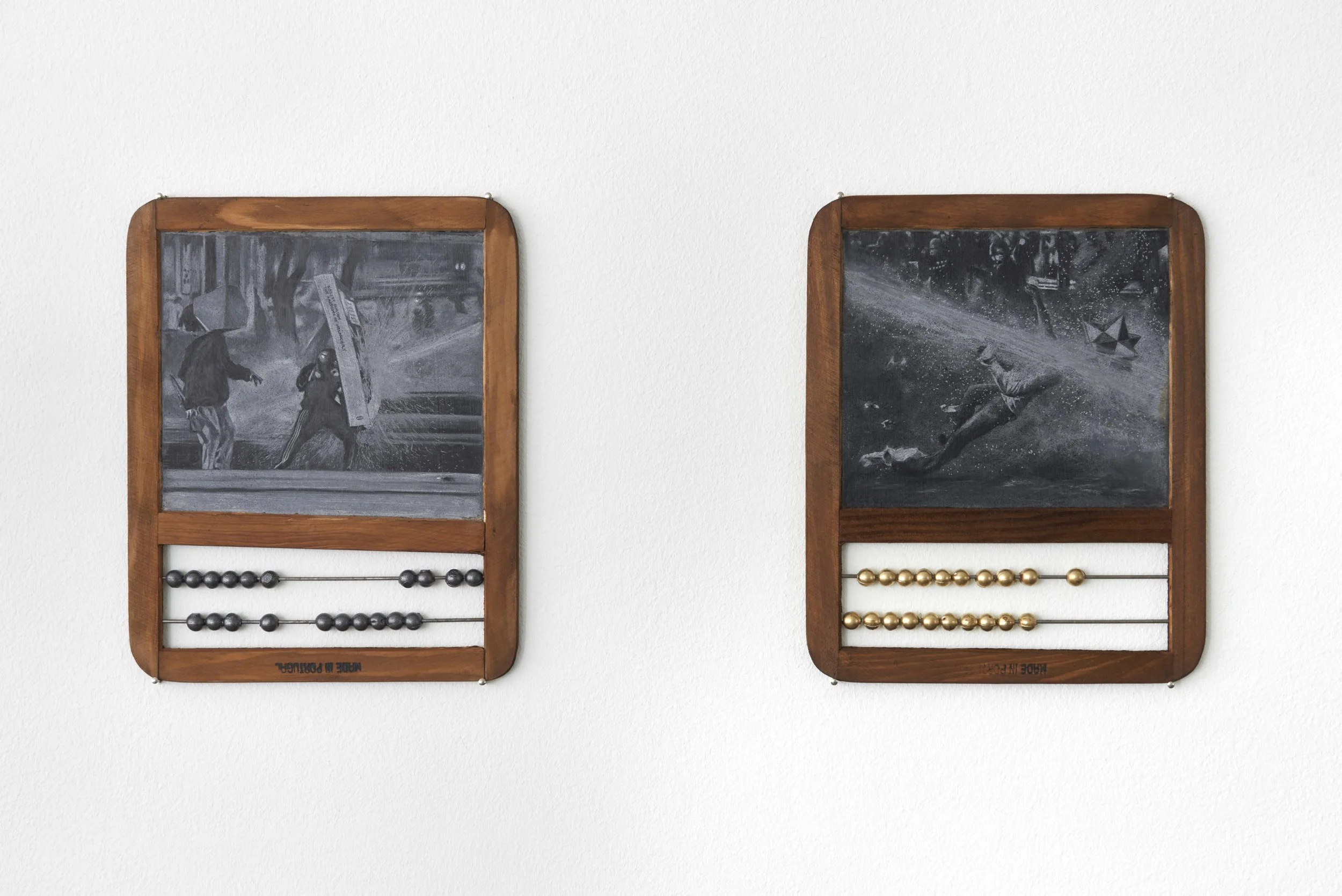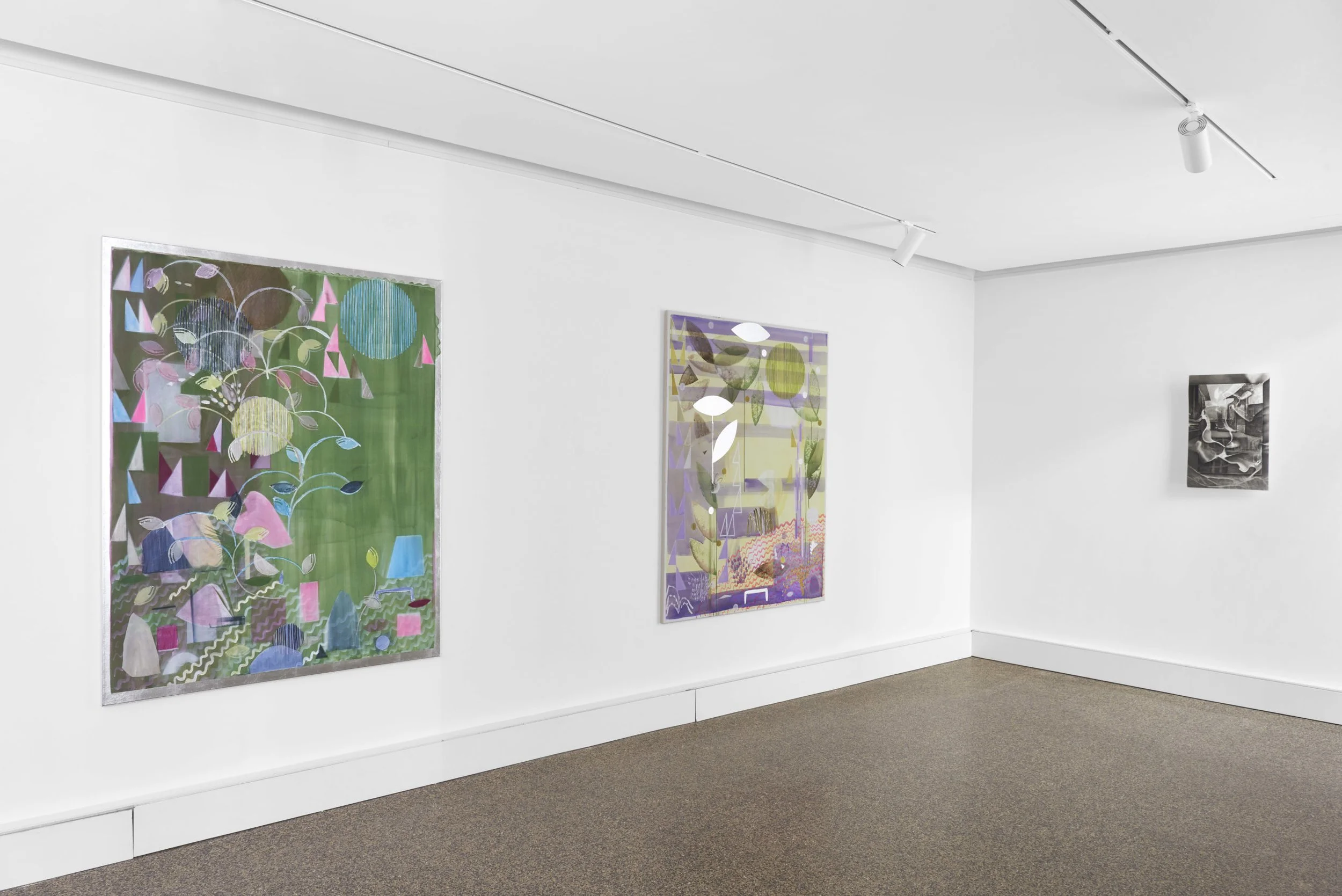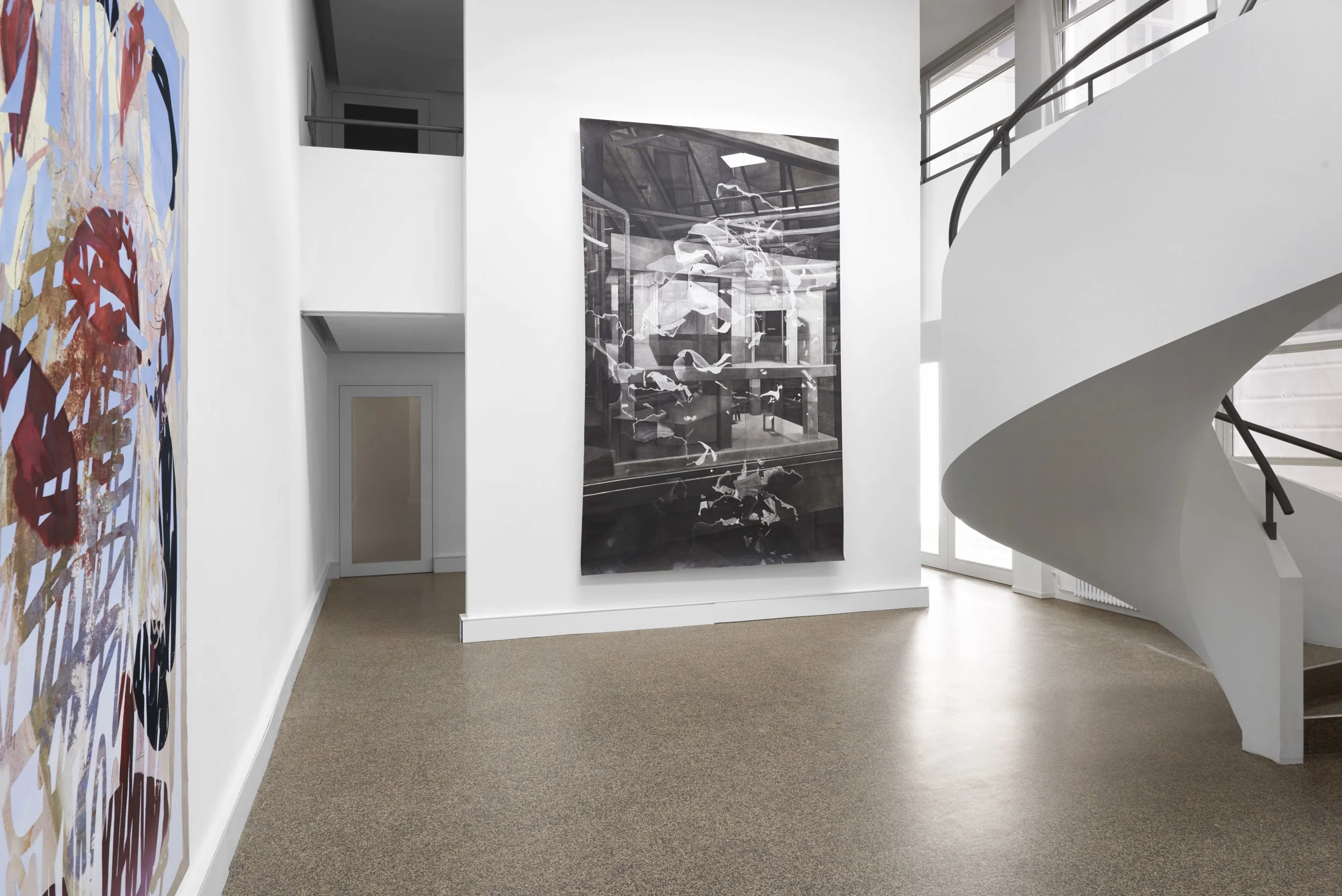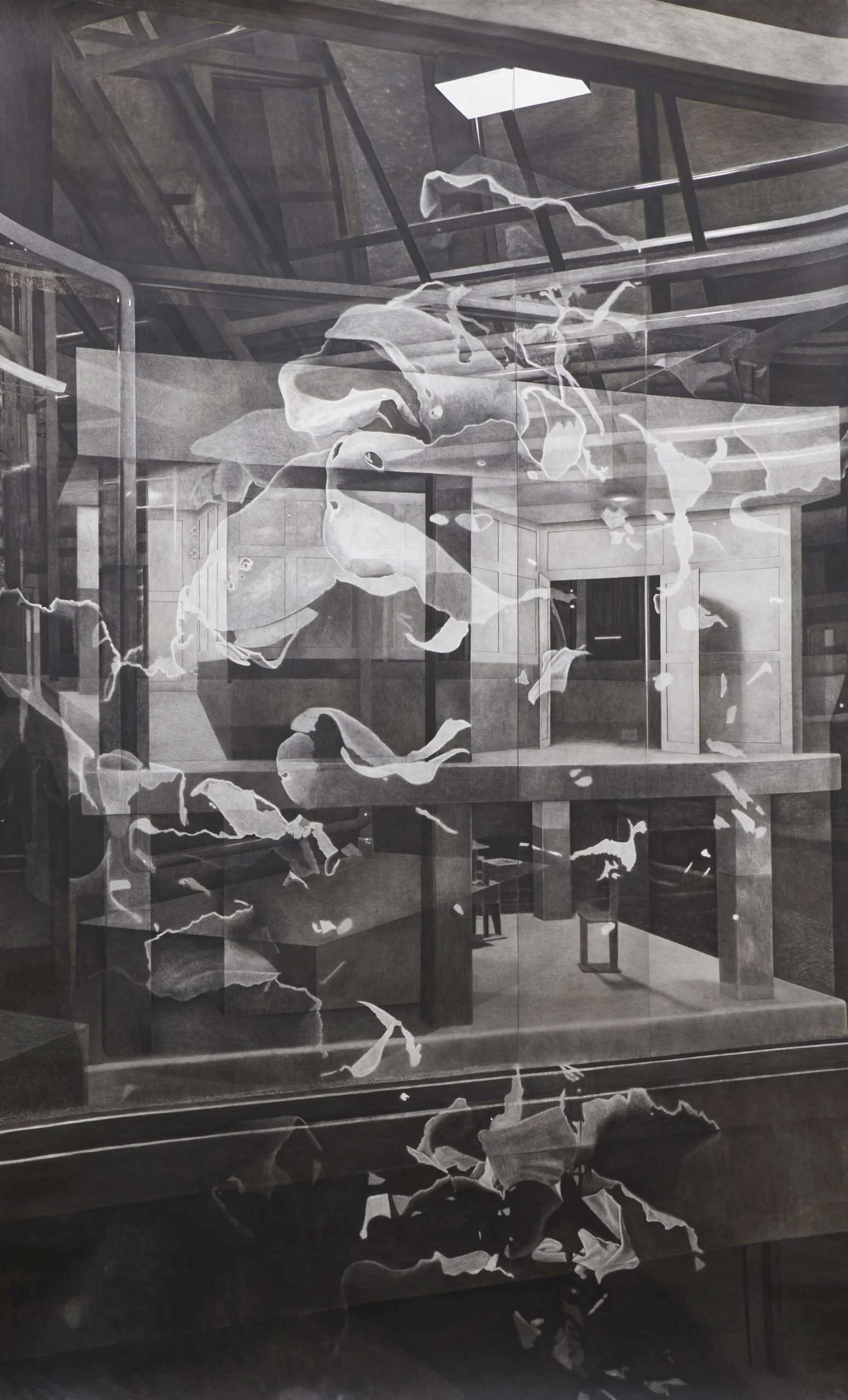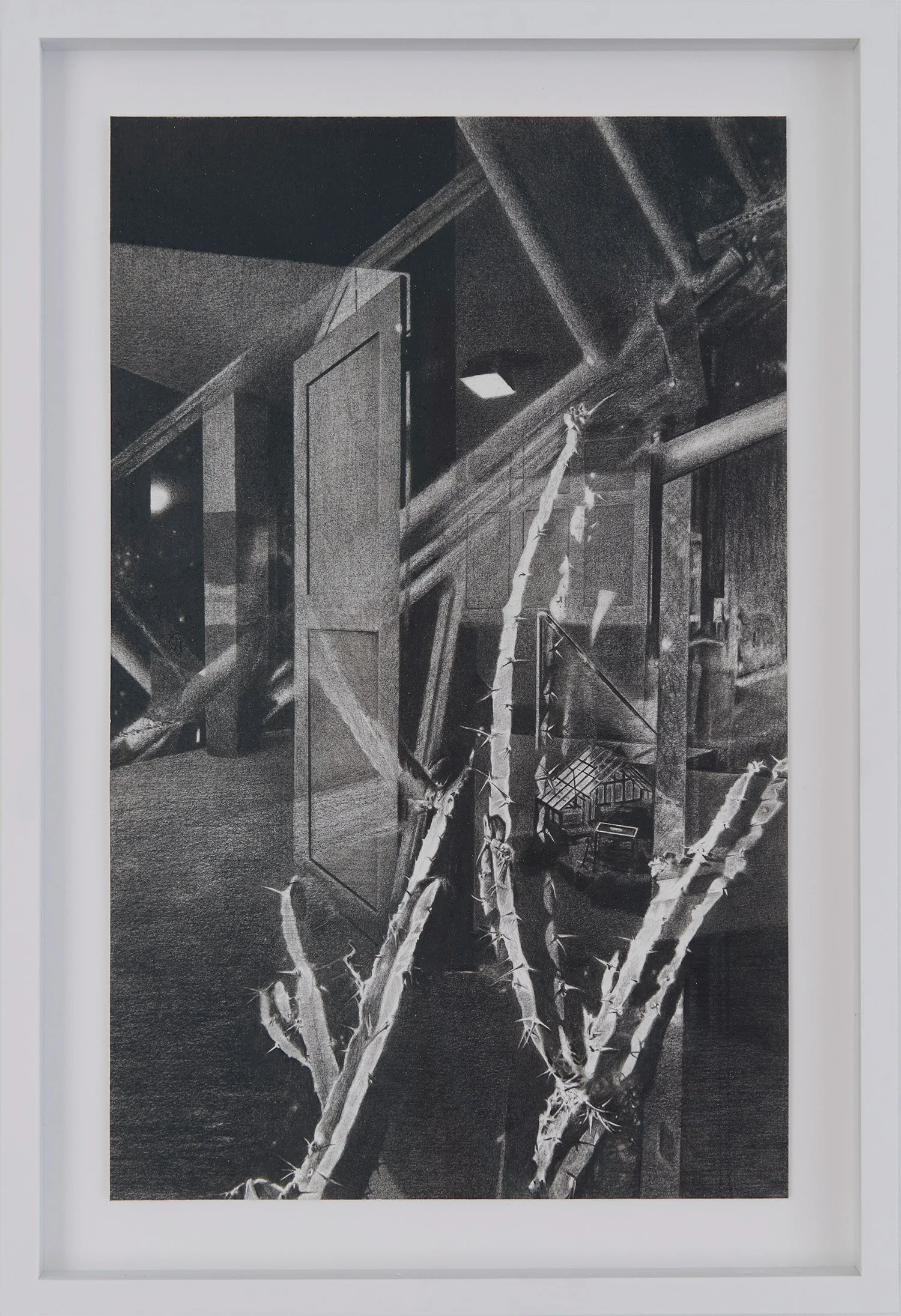Charlotte Herzig, Stefanie Kägi,
Andrea Mastrovito, Tobias Nussbaumer, and Olga Titus
May Be Closer (Part II)
Even though the movement appears static, our eyes continue to make the journey, using the one thing that AI will struggle to successfully emulate, our imagination.
"Objects in a mirror may be closer than they appear" is a text found on the rear-view mirrors of cars in several countries, including the US, India, and South Korea. It asserts or warns that our perspectives are skewed and do not reflect reality. The artists in the second part of this two-part exhibition question their role in creating ever-shifting views.
Reflective surfaces shimmer in the latest paintings by Charlotte Herzig. Using silver leaf, the artist has framed one work in this light-catching material while using it sparingly in another to create one of her signature motifs, which itself resembles a leaf. Her visual language, one that's dreamlike, fantastical, full of subtleties, neither too organic nor too geometric, is again found in these two works and their small counterpart on the upper floors of the gallery. They bring their viewer to an enchanted place, a fluorescent, techno-colored garden that is hard to imagine as being real and if so, can only be found under the sea.
Across from Herzig's work hangs Olga Titus's painting. The artist digitally draws two paintings and then prints them on both sides of a sequins-lined canvas. The works shimmer in the light, and depending on which side of the sequins is visible, the painterly line of the artist becomes more prevalent. As the artworks can be gently touched, one can, in the privacy of their own homes, work on the piece themselves, finding a moment that speaks to them, colors that evoke memories, or an emotional response. Uniquely, the work on the gallery's first floor contains figurative imagery, unusual for the artist but reminiscent of her video work. They reflect more directly her Malaysian of Indian descent roots on her father's side, with bold colors and Hindu iconography dominantly shining through.
Layered fields of color move between the fore and backgrounds in the Vessel paintings of Stefanie Kägi. The Berlin-based, Winterthur-born artist mixes the digital and the analog, drawing the forms on her computer and then extracting a negative of the image, which she then transfers onto the canvas. The result is an interplay of controlled and accidental elements, with a background that flows into a subtle gradient, dark at the top and light at the bottom; the objects seem to float. Like the vessels themselves, which are about filling and emptying, the paintings, too, are about overlaying layers and partially erasing them again.
The layering and combination of artistic techniques are essential to the oeuvre of Andrea Mastrovito. "Mastrovito's entire quest is aimed at retrieving the germinal component, and, in this age of hyper-technology, he prefers simple elements that are reminders of school days: rulers, desks, and blackboards, or ancient techniques such as intarsia, stained glass, collage, frottage, and animation film." (Fiz, Alberto, To Draw is to Know, Città di Castello, Perugia, Italy, Magonza, January 2023) The collage-drawing-frottage works in the exhibition all center on the theme of melancholia; every flower is a frottage of a book about melancholy, war, and spleen. Two (The Stranger and The Rebel) contain direct references to the French existentialist Albert Camus, while The End of the Night (2022) borrows inspiration from Albrecht Dürer's famous engraving Melencolia I (1514). Upstairs are two precious blackboard works engraved in repurposed school abacuses. The works, showing moments in a protest when police are hosing down demonstrators, do not reference any particular event. Instead, they are about the precariousness of life and the fact that it can easily disappear – be erased – in one second. In The story of Melancholy (2022), again an ode to Dürer, one can see that culture/thought and fight/revolt is the only answer to erasure.
Iconic imagery such as these is forever engrained in our collective consciousness. Just as for Mastrovito, memory, and erasure is also of paramount interest to the Basel-born and based artist Tobias Nussbaumer. Nussbaumer continues to push the boundaries of what AI can do for us and art. At a time when ChatGPT is threatening and reinventing our most beloved search engines, the subject seems ever more topical. For Nussbaumer, however, this has been the subject of his artistic practice for over a decade. He starts by creating virtual worlds, then runs them through a generative adversarial network (GAN), a form of machine learning. The AI returns some version of it, and a back-and-forth ensues. Through this process, Nussbaumer trains the GAN on thousands of images, which at this point consists of a blending of other GAN-generated images and those from his virtual worlds. The two have become so entwined it's no longer possible to distinguish the source. A riff between artist and AI forms an ever-evolving virtual world, in video format, that morphs between input and output, but which is which becomes moot. Once Nussbaumer is satisfied with their collaboration, he finds a moment from the video, reinterprets its composition, and meticulously draws it in ink and black pencil. The result is a combination of reality, discernable moments in the image, and recognizable elements overlaid with unexpected architectural settings. The artist thus questions our perspectives, prejudices, and the connotations we make. Reflections continue to infinity, much like the infinity sculptures popularized by many contemporary artists. However, even though the movement appears static, our eyes continue to make the journey, using the one thing that AI will struggle to successfully emulate, our imagination.
Stefanie Kägi, Scribbling #1, 2021, Oil, pigment, monotype on canvas, 250 x 190 cm
Stefanie Kägi, Vessel Painting (Pomponette), 2022, Oil, pigment, oil stick on cotton, 190 x 135 cm
Andrea Mastrovito, The Rebel, 2022, Frottage and collage on paper, 57 x 45 cm
Andrea Mastrovito, The Stranger, 2022, Frottage and collage on paper, 135 x 76 cm
Tobias Nussbaumer, Study for Memories of a Network 1, 2022, Black pencil and ink on paper, 230 x 370 cm
Andrea Mastrovito, The End of the Night, 2022, Frottage and collage on paper, 61 x 108 cm
Tobias Nussbaumer, Whisper Through the Glass, 2018, Black pencil and ink on paper, 370 x 230 cm
Tobias Nussbaumer, Customized Seclusion, 2019, Black pencil and ink on paper, 39 x 24,5 cm
Tobias Nussbaumer, Superficial Knowledge, 2018, Black pencil and ink on paper, 39 x 24,5 cm
Charlotte Herzig, DeepSeeds, 2023, Acrylic and aluminium on canvas, 155 x 120 cm
Charlotte Herzig, Hum to Sleep, 2023, Acrylic and aluminium on canvas, 155 x 120 cm
Olga Titus, Ohne Titel, 2022, Reversible sequins printed on both sides on non-woven linen, 122 x 92 cm, Edition of 7
Andrea Mastrovito, Zero Casualties IV, 2021, Carved blackboard, abacus, 26 x 21 cm
Andrea Mastrovito, The story of Melancholy, 2021, Carved blackboard, abacus, 30 x 23 cm
Tobias Nussbaumer, Twin Collapse, 2023, Black pencil and ink on paper, 105 x 170 cm
Tobias Nussbaumer, Study for Memories of a Network 2, 2022, Black pencil and ink on paper, 49 x 110 cm
Olga Titus, Ohne Titel, 2021, Reversible sequins printed on both sides on non-woven linen, 120 x 90 cm, Edition of 7
Charlotte Herzig, Green Crutch, 2022, Acrylic on canvas, 52,5 x 75 cm
Stefanie Kägi, Vessel Painting (Lady of the Spirit), 2022, Oil, pigment, monotype on canvas, 190 x 135 cm
Charlotte Herzig, Stefanie Kägi, Andrea Mastrovito, Tobias Nussbaumer and Olga Titus
May Be Closer (Part II)
16.02. — 06.04.2023
Wilde Gallery, Angensteinerstrasse 37, 4052 Basel
All images courtesy the artist and Wilde
Installation photos: Philipp Hänger
